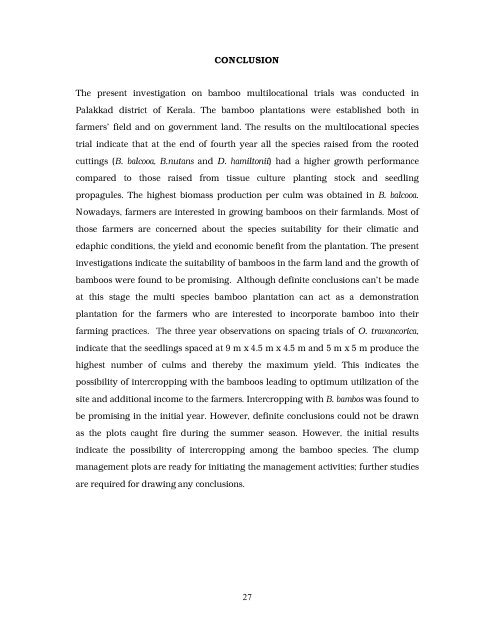Multilocational field trials for selected bamboo species
Multilocational field trials for selected bamboo species
Multilocational field trials for selected bamboo species
You also want an ePaper? Increase the reach of your titles
YUMPU automatically turns print PDFs into web optimized ePapers that Google loves.
CONCLUSION<br />
The present investigation on <strong>bamboo</strong> multilocational <strong>trials</strong> was conducted in<br />
Palakkad district of Kerala. The <strong>bamboo</strong> plantations were established both in<br />
farmers’ <strong>field</strong> and on government land. The results on the multilocational <strong>species</strong><br />
trial indicate that at the end of fourth year all the <strong>species</strong> raised from the rooted<br />
cuttings (B. balcooa, B.nutans and D. hamiltonii) had a higher growth per<strong>for</strong>mance<br />
compared to those raised from tissue culture planting stock and seedling<br />
propagules. The highest biomass production per culm was obtained in B. balcooa.<br />
Nowadays, farmers are interested in growing <strong>bamboo</strong>s on their farmlands. Most of<br />
those farmers are concerned about the <strong>species</strong> suitability <strong>for</strong> their climatic and<br />
edaphic conditions, the yield and economic benefit from the plantation. The present<br />
investigations indicate the suitability of <strong>bamboo</strong>s in the farm land and the growth of<br />
<strong>bamboo</strong>s were found to be promising. Although definite conclusions can’t be made<br />
at this stage the multi <strong>species</strong> <strong>bamboo</strong> plantation can act as a demonstration<br />
plantation <strong>for</strong> the farmers who are interested to incorporate <strong>bamboo</strong> into their<br />
farming practices. The three year observations on spacing <strong>trials</strong> of O. travancorica,<br />
indicate that the seedlings spaced at 9 m x 4.5 m x 4.5 m and 5 m x 5 m produce the<br />
highest number of culms and thereby the maximum yield. This indicates the<br />
possibility of intercropping with the <strong>bamboo</strong>s leading to optimum utilization of the<br />
site and additional income to the farmers. Intercropping with B. bambos was found to<br />
be promising in the initial year. However, definite conclusions could not be drawn<br />
as the plots caught fire during the summer season. However, the initial results<br />
indicate the possibility of intercropping among the <strong>bamboo</strong> <strong>species</strong>. The clump<br />
management plots are ready <strong>for</strong> initiating the management activities; further studies<br />
are required <strong>for</strong> drawing any conclusions.<br />
27

















